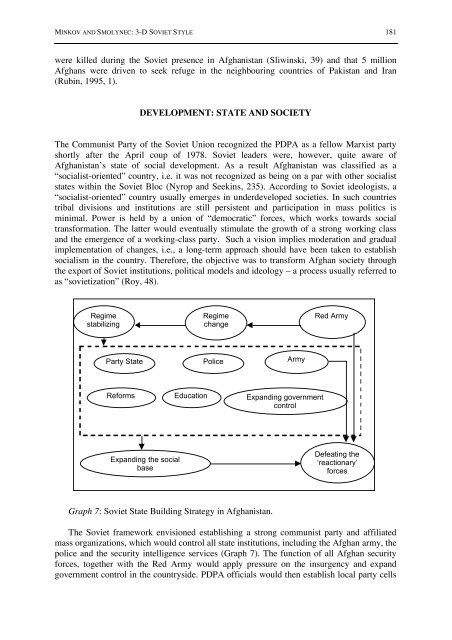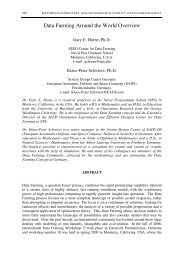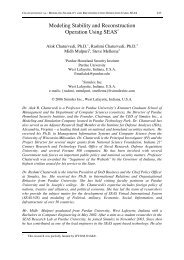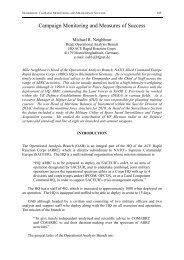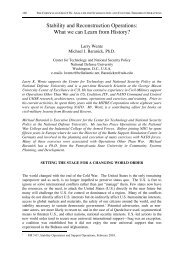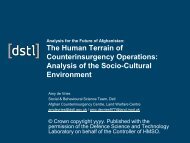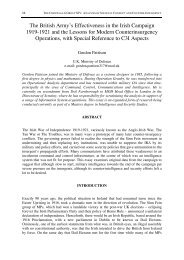MINKOV AND SMOLYNEC: 3-D SOVIET STYLE 181were killed dur<strong>in</strong>g <strong>the</strong> <strong>Soviet</strong> presence <strong>in</strong> Afghanistan (Sliw<strong>in</strong>ski, 39) and that 5 millionAfghans were driven to seek refuge <strong>in</strong> <strong>the</strong> neighbour<strong>in</strong>g countries of Pakistan and Iran(Rub<strong>in</strong>, 1995, 1).DEVELOPMENT: STATE AND SOCIETYThe Communist Party of <strong>the</strong> <strong>Soviet</strong> Union recognized <strong>the</strong> PDPA as a fellow Marxist partyshortly after <strong>the</strong> April coup of 1978. <strong>Soviet</strong> leaders were, however, quite aware ofAfghanistan’s state of social development. As a result Afghanistan was classified as a“socialist-oriented” country, i.e. it was not recognized as be<strong>in</strong>g on a par with o<strong>the</strong>r socialiststates with<strong>in</strong> <strong>the</strong> <strong>Soviet</strong> Bloc (Nyrop and Seek<strong>in</strong>s, 235). Accord<strong>in</strong>g to <strong>Soviet</strong> ideologists, a“socialist-oriented” country usually emerges <strong>in</strong> underdeveloped societies. In such countriestribal divisions and <strong>in</strong>stitutions are still persistent and participation <strong>in</strong> mass politics ism<strong>in</strong>imal. Power is held by a union of “democratic” forces, which works towards socialtransformation. The latter would eventually stimulate <strong>the</strong> growth of a strong work<strong>in</strong>g classand <strong>the</strong> emergence of a work<strong>in</strong>g-class party. Such a vision implies moderation and gradualimplementation of changes, i.e., a long-term approach should have been taken to establishsocialism <strong>in</strong> <strong>the</strong> country. Therefore, <strong>the</strong> objective was to transform Afghan society through<strong>the</strong> export of <strong>Soviet</strong> <strong>in</strong>stitutions, political models and ideology – a process usually referred toas “sovietization” (Roy, 48).Regimestabiliz<strong>in</strong>gRegimechangeRed ArmyParty StatePoliceArmyReformsEducationExpand<strong>in</strong>g governmentcontrolExpand<strong>in</strong>g <strong>the</strong> socialbaseDefeat<strong>in</strong>g <strong>the</strong>‘reactionary’forcesGraph 7: <strong>Soviet</strong> State Build<strong>in</strong>g Strategy <strong>in</strong> Afghanistan.The <strong>Soviet</strong> framework envisioned establish<strong>in</strong>g a strong communist party and affiliatedmass organizations, which would control all state <strong>in</strong>stitutions, <strong>in</strong>clud<strong>in</strong>g <strong>the</strong> Afghan army, <strong>the</strong>police and <strong>the</strong> security <strong>in</strong>telligence services (Graph 7). The function of all Afghan securityforces, toge<strong>the</strong>r with <strong>the</strong> Red Army would apply pressure on <strong>the</strong> <strong>in</strong>surgency and expandgovernment control <strong>in</strong> <strong>the</strong> countryside. PDPA officials would <strong>the</strong>n establish local party cells
182 THE CORNWALLIS GROUP XII: ANALYSIS FOR MULTI-AGENCY SUPPORTand appo<strong>in</strong>t state representatives. Toge<strong>the</strong>r <strong>the</strong>y would enforce <strong>the</strong> social reforms, <strong>in</strong>itiatedby <strong>the</strong> regime. A crucial aspect of <strong>the</strong> sovietization process <strong>in</strong> Afghanistan was work<strong>in</strong>g with<strong>the</strong> youth, educat<strong>in</strong>g a new generation accord<strong>in</strong>g to <strong>Soviet</strong> curricula (Roy, 48). Thecomb<strong>in</strong>ation of gradual expansion of government control, implementation of social andeconomic reforms, as well as secur<strong>in</strong>g <strong>the</strong> support of <strong>the</strong> future generation, under <strong>the</strong>leadership of PDPA was supposed to expand <strong>the</strong> social base of <strong>the</strong> regime and ultimatelydeny support for <strong>the</strong> <strong>in</strong>surgency.The <strong>Soviet</strong>s regarded <strong>the</strong> PDPA as <strong>the</strong> key <strong>in</strong>stitution <strong>in</strong> foster<strong>in</strong>g a <strong>Soviet</strong> type of state.At <strong>the</strong> end of 1979, when <strong>the</strong> 40 th Army entered Afghanistan, <strong>the</strong> situation was exactly <strong>the</strong>opposite – <strong>the</strong> party was divided, <strong>in</strong>terfactional fight<strong>in</strong>g was tak<strong>in</strong>g place; and it was los<strong>in</strong>gits grip on <strong>the</strong> government, <strong>the</strong> army and <strong>the</strong> security situation <strong>in</strong> <strong>the</strong> countryside.Soon after its creation <strong>in</strong> 1965, PDPA had split <strong>in</strong>to two factions – Khalq and Parcham,only to reunite under pressure <strong>from</strong> <strong>the</strong> <strong>Soviet</strong> Union <strong>in</strong> 1977 (Nyrop and Seek<strong>in</strong>s, 226). Thedifferences between <strong>the</strong> two factions did not disappear and came to <strong>the</strong> surface aga<strong>in</strong> after <strong>the</strong>1978 revolution. The real power after <strong>the</strong> April Revolution, however, rested with <strong>the</strong>leadership of <strong>the</strong> Khalq faction and <strong>the</strong> Parcham faction was repressed. When PDPA tookpower <strong>in</strong> 1978, its membership was around 18,000. Although membership quickly grew, itwas estimated that by <strong>the</strong> end of 1979, 16-17,000 PDPA members had been killed, purged orhad left <strong>the</strong> party (Giustozzi, 4). This situation not only affected <strong>the</strong> party’s morale but alsothat of <strong>the</strong> army, which was <strong>the</strong> <strong>in</strong>stitution with largest representation of PDPA members.The large number of desertions fur<strong>the</strong>r weakened <strong>the</strong> army. Most importantly, <strong>the</strong> Khalqregime lost <strong>in</strong>ternal legitimacy, i.e., <strong>the</strong> support of <strong>the</strong> state bureaucracy. S<strong>in</strong>ce <strong>the</strong><strong>in</strong>surgency was not yet <strong>in</strong> <strong>the</strong> position to pose any threat to <strong>the</strong> existence of <strong>the</strong> government,<strong>the</strong>re is no doubt that <strong>the</strong> level of dis<strong>in</strong>tegration of state and party <strong>in</strong> 1979 was one of <strong>the</strong>ma<strong>in</strong> reasons for <strong>the</strong> <strong>Soviet</strong> <strong>in</strong>tervention (Rub<strong>in</strong>, 1995, 121). It is not a surprise <strong>the</strong>n thatreconstruction of <strong>the</strong>se two <strong>in</strong>stitutions was <strong>the</strong> ma<strong>in</strong> priority for <strong>the</strong> <strong>Soviet</strong>s.In <strong>the</strong> <strong>Soviet</strong> system <strong>the</strong>re is a close overlap between party and state and thus, <strong>the</strong> <strong>Soviet</strong>style of governance is commonly referred to as <strong>the</strong> “party-state.” The structure of PDPA wasmodeled after <strong>the</strong> Communist Party of <strong>the</strong> <strong>Soviet</strong> Union with <strong>the</strong> executive comprised of aCentral Committee and a Politburo, <strong>the</strong> latter led by a Secretary General. These were, <strong>in</strong><strong>the</strong>ory, elected <strong>from</strong> <strong>the</strong> Party Congress. The Congress also nom<strong>in</strong>ated <strong>the</strong> prov<strong>in</strong>cial partyleaders on prov<strong>in</strong>cial, district and subdistrict level. The state structure paralleled <strong>the</strong> partyone with a Cab<strong>in</strong>et, Revolutionary Council, and a Presidum, led by a President (Nyrop andSeek<strong>in</strong>s, 259-60; Roy, 49). The Secretary General, who also held <strong>the</strong> post of President, andmany o<strong>the</strong>r party functionaries, occupy<strong>in</strong>g positions <strong>in</strong> <strong>the</strong> correspond<strong>in</strong>g state level, ensured<strong>the</strong> dom<strong>in</strong>ance of <strong>the</strong> PDPA (Rub<strong>in</strong>, 1995, 128). On a regional level party control wasexercised by <strong>the</strong> Governors and <strong>the</strong> district and subdistrict commissioners be<strong>in</strong>g partymembers as well. This control, however, was underm<strong>in</strong>ed by <strong>the</strong> cont<strong>in</strong>ued factionalismwith<strong>in</strong> <strong>the</strong> Party and <strong>the</strong> difficult security situation <strong>in</strong> most of <strong>the</strong> countryside. Theperformance of both party and state structures was affected by rivalry between Khalk andParcham (Rub<strong>in</strong>, 1995, 128; Nyrop and Seek<strong>in</strong>s, 260). Members of <strong>the</strong> two factions fought tosecure dom<strong>in</strong>ance <strong>in</strong> <strong>the</strong> different organizational units, which often prevented <strong>the</strong>m <strong>from</strong>function<strong>in</strong>g properly. The security situation, on <strong>the</strong> o<strong>the</strong>r hand, prevented <strong>the</strong> party <strong>from</strong>establish<strong>in</strong>g its structures <strong>in</strong> <strong>the</strong> prov<strong>in</strong>ces below governor level. District and subdistrictcommissioners, if appo<strong>in</strong>ted, had very few opportunities of visit<strong>in</strong>g <strong>the</strong>ir jurisdictions(Giustozzi, 37). Party cells <strong>in</strong> villages grew <strong>from</strong> 277 <strong>in</strong> 1983 to 1,160 <strong>in</strong> 1987 (Giustozzi,


